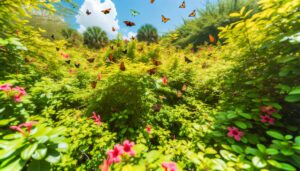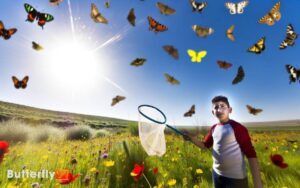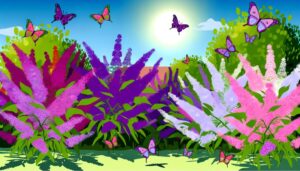Does Butterfly Poop Look Like Anything Specific?
Butterfly excrement, known as frass, is typically small, dark brown or black pellets, appearing cylindrical and often less than a millimeter in width. This solid waste, sometimes containing liquid droplets, varies in color from dark brown to green, influenced by the butterfly's diet and species.
Frass consists mainly of undigested food particles and metabolic by-products. Its granular or slightly moist texture is essential for maintaining water balance in butterflies.
The physical characteristics of frass can provide valuable insights into butterfly physiology and health. Understanding these details can enrich one's knowledge of butterfly biology and their ecological roles.
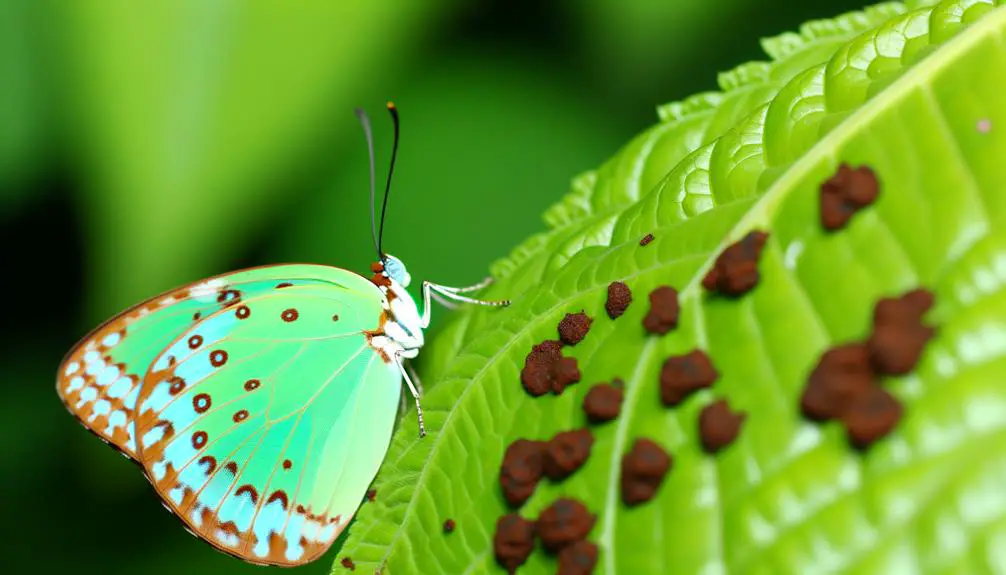
Key Takeaways
- Butterfly frass typically appears dark brown or black and is mostly solid.
- The excrement is small, cylindrical, and pellet-like, usually under a millimeter wide.
- Frass can also include liquid forms, especially when butterflies consume a liquid diet like nectar.
- Color variations in frass depend on dietary intake, ranging from dark brown to greenish.
Why Butterflies Poop
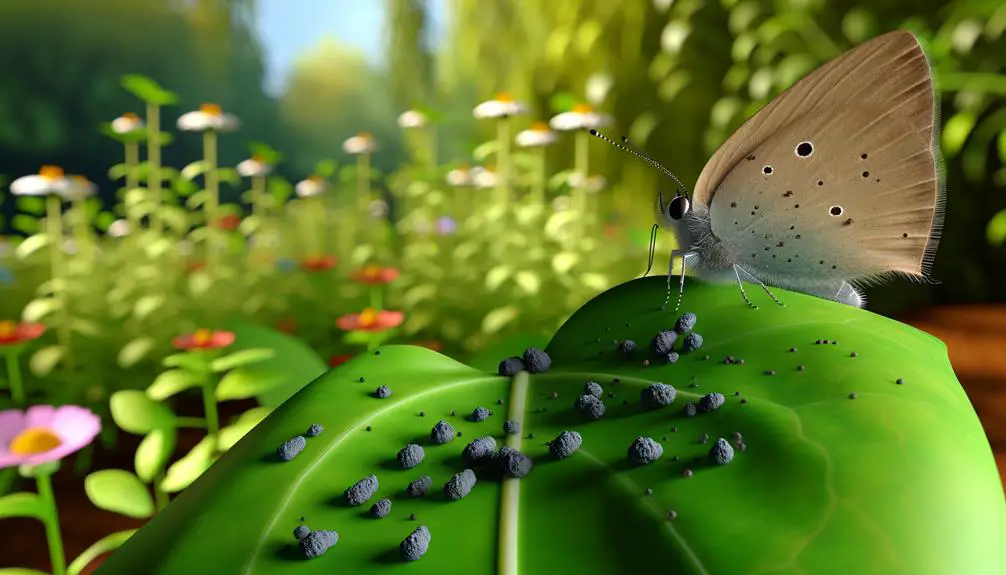
Butterflies excrete waste primarily to expel undigested food and metabolic by-products from their bodies. This excretory process is essential for maintaining homeostasis by eliminating excess substances that could be toxic if accumulated.
Butterflies consume various liquids, such as nectar and rotting fruit juices, which are rich in sugars and other nutrients. However, not all ingested materials are fully absorbed. The digestive system breaks down these substances, and the resultant waste, comprising indigestible components and metabolic waste products like uric acid, is expelled.
Efficient waste elimination guarantees that butterflies can continue to intake nutrients without adverse effects on their physiological processes. This excretion is critical for their survival, allowing them to maintain the delicate balance necessary for their metabolic functions.
Composition of Butterfly Waste
The composition of butterfly waste primarily consists of uric acid, undigested food particles, and other metabolic by-products. These elements offer insight into the physiological processes of butterflies.
Uric acid is a nitrogenous compound resulting from the breakdown of proteins and is excreted as a solid to conserve water, essential for their survival. Undigested food particles indicate that not all ingested substances are absorbed efficiently. Metabolic by-products include various compounds resulting from cellular activities.
Consider the following fascinating aspects:
- Uric acid: A key waste product, reducing water loss.
- Undigested particles: Reflects the efficiency of their digestive system.
- Metabolic by-products: By-products from cellular processes.
- Water conservation: Critical for butterfly survival.
Understanding these components aids in appreciating butterfly biology.
Typical Appearance
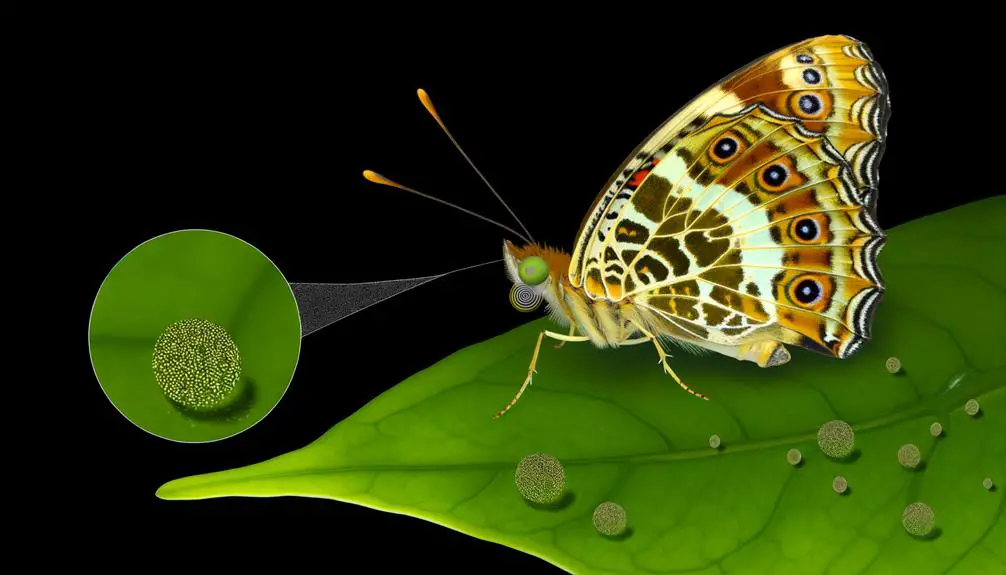
Butterflies exhibit a remarkable range of colors and patterns, primarily due to the microscopic scales on their wings that reflect light in various ways.
Typically, their sizes can vary considerably, with wingspans ranging from a mere half-inch to nearly twelve inches.
The shape of butterfly wings also varies, often aiding in species identification and playing a role in their aerodynamic flight capabilities.
Color and Consistency
Exhibiting a broad spectrum of hues and patterns, butterfly wings are characterized by their intricate scales which reflect and refract light to produce vibrant colors. These delicate wing patterns not only serve as camouflage or warning signals to predators but also play a role in attracting mates. The symbolism of butterflies extends beyond nature, influencing art and traditions worldwide; for instance, the butterfly tattoo meaning in cultures often represents transformation, freedom, or the soul’s journey. Various societies view the butterfly as a sign of renewal, drawing inspiration from its metamorphosis from a caterpillar into a graceful, winged creature.
In contrast, the excrement of butterflies, known as frass, is typically less vivid. The color and consistency of frass can vary based on the butterfly's diet, but it generally appears as small, dark pellets or liquid droplets.
Key characteristics of butterfly poop include:
- Color: Often dark brown or black
- Consistency: Mostly solid with occasional liquid forms
- Appearance: Small, pellet-like or minuscule droplets
- Composition: Plant material and waste products
This detailed understanding helps in identifying and studying butterfly habits and environments.
Size and Shape
With respect to size and shape, butterfly wings typically range from a few millimeters to over 30 centimeters in wingspan, exhibiting a diverse array of forms that contribute to their aerodynamic efficiency and ecological adaptability.
Correspondingly, butterfly excrement, or frass, is typically small, cylindrical, and pellet-like in shape, reflecting the diminutive size of these insects.
The dimensions of frass are generally proportional to the butterfly's size, often measuring less than a millimeter in width and a few millimeters in length.
The shape is usually elongated and slightly tapered, facilitating its passage through the digestive system.
The frass's structural integrity is maintained by chitinous residues from the insect's diet, providing a uniform appearance that aids in identification.
Color Variations
Butterfly color variations are primarily influenced by two factors: the pigments present in their scales and their dietary intake.
Pigments such as melanins, carotenoids, and pterins contribute to a wide range of hues and patterns observed in various species.
Additionally, the specific nutrients and compounds consumed by caterpillars and adult butterflies can affect coloration, leading to remarkable diversity within and across populations.
Pigment Influences
The diverse color variations in butterfly wings are primarily influenced by the presence and distribution of pigments such as melanins, carotenoids, and pterins.
Melanins contribute to black and brown hues, while carotenoids are responsible for yellow, orange, and red shades.
Pterins, on the other hand, generate white and sometimes yellow colors, enhancing the vibrancy of these delicate creatures.
These pigments are embedded within the scales of butterfly wings, creating iridescent patterns that captivate observers.
Understanding these pigments can evoke a sense of wonder:
- Melanins: Deep, rich blacks and browns
- Carotenoids: Vibrant yellows, oranges, and reds
- Pterins: Bright whites and yellows
- Scales: Microscopic structures housing pigments
The intricate interplay of these pigments forms the basis of butterfly wing coloration.
Dietary Impact
Dietary intake plays a vital role in determining the intensity and variation of butterfly wing colors, as it directly influences the availability and concentration of pigments such as carotenoids and pterins.
Carotenoids, acquired from plant sources, contribute to yellow, orange, and red hues, whereas pterins, synthesized by the butterflies themselves, are responsible for whites and some yellows.
Variations in diet, particularly during the larval stage, can lead to significant differences in wing coloration among individuals of the same species. A nutrient-rich diet enhances pigment concentration, resulting in more vivid and diverse color patterns.
Conversely, a poor diet may yield duller hues, reflecting the direct impact of nutritional quality on pigmentation.
Understanding these dietary influences is essential for ecological research and conservation efforts.
Texture and Consistency
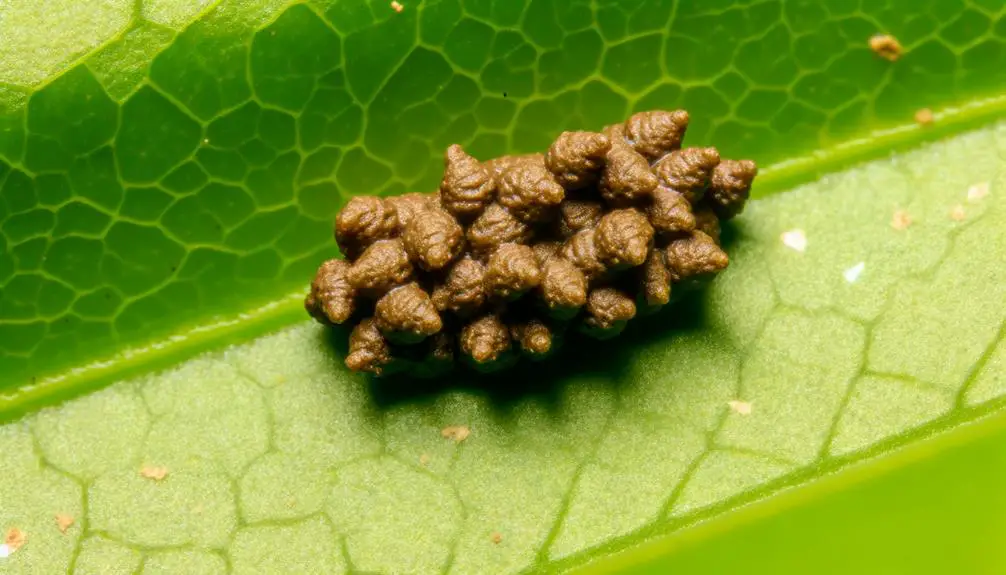
Unlike the smooth and rigid exoskeletons of many insects, butterfly wings possess a unique combination of delicate scales and intricate textures that contribute to their flexibility and iridescence. This complexity extends to their excretion.
Butterfly feces, scientifically termed 'frass,' exhibit a texture and consistency that can vary based on diet and hydration levels. Typically, frass is semi-liquid and can appear as small droplets or smears.
- Semi-liquid texture: Reflects high water content.
- Small droplet form: Minimal solid waste.
- Smears on surfaces: Indicates mobility and feeding behavior.
- Color variation: Ranges from green to brown, depending on ingested substances.
This variability underscores the biological diversity within Lepidoptera.
Frequency of Excretion
Understanding the frequency of excretion in butterflies provides additional insights into their metabolic processes and overall health.
Butterflies typically excrete waste in the form of liquid droplets, known as meconium, particularly during the early stages post-emergence from the chrysalis.
The frequency of this excretion can vary widely depending on factors such as species, diet, and environmental conditions.
Generally, adult butterflies may excrete several times a day due to their liquid diet primarily composed of nectar.
The rapid digestion of this sugar-rich diet necessitates frequent excretion to maintain metabolic balance and prevent the accumulation of waste products.
These excretory patterns are essential indicators of their physiological states and help entomologists monitor butterfly health and behavior effectively.
Impact on Plants
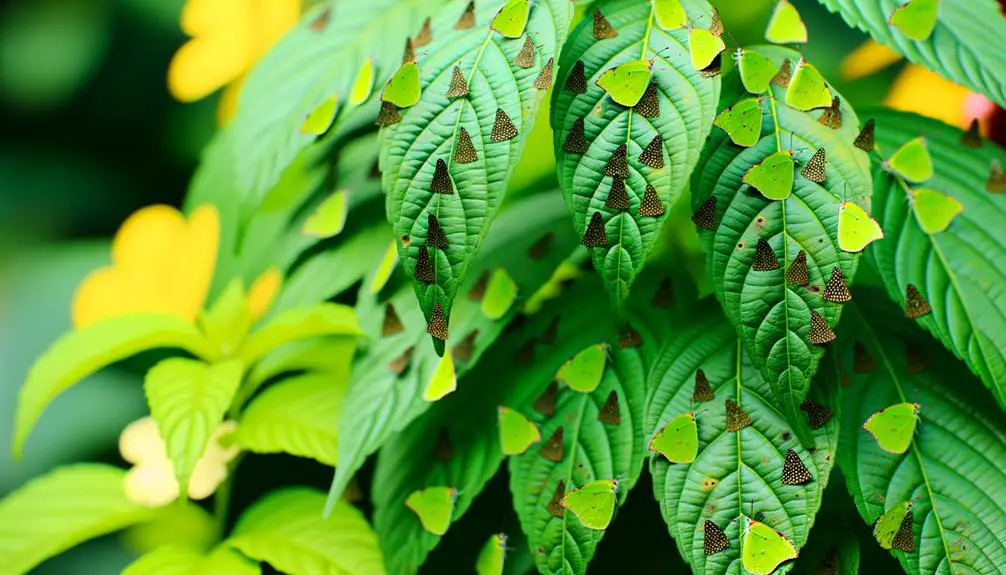
Butterflies play an essential role in the ecosystem by contributing to nutrient-rich soil through their excretions, which enhance plant growth.
However, the feeding habits of caterpillars, the larval stage of butterflies, can result in significant damage to foliage, potentially impacting plant health.
Understanding the dual nature of butterflies' interactions with plants is vital for effective ecosystem management and conservation strategies.
Nutrient-Rich Soil Contribution
Nutrient-rich soil greatly enhances plant health and growth by providing essential minerals and organic matter that support root development and overall plant vigor.
Butterfly frass, or poop, contributes to this nutrient enrichment, creating a fertile environment for plants to thrive. The organic matter in butterfly frass decomposes, releasing essential nutrients into the soil.
This biological contribution results in:
- Enhanced nitrogen levels: Promotes lush, green foliage.
- Increased phosphorus: Supports robust root growth and flower production.
- Improved soil structure: Enhances aeration and water retention.
- Boosted microbial activity: Facilitates nutrient cycling and plant health.
Understanding these benefits underscores the significant role butterfly frass plays in fostering an environment conducive to vibrant plant life.
Potential Plant Damage
Despite the numerous benefits of butterfly frass to soil health, it's important to contemplate the potential adverse effects butterflies can have on plants, particularly through their larval feeding habits which can result in significant foliage damage. Caterpillars, the larval stage of butterflies, consume large quantities of plant material, potentially leading to defoliation and decreased plant vigor. This feeding can impact agricultural crops as well as ornamental plants, posing economic and aesthetic concerns.
| Impact | Emotional Response |
|---|---|
| Defoliation | Concern for plant health |
| Reduced Yield | Worry about crop loss |
| Aesthetic Damage | Disappointment in garden appearance |
Understanding the dual role of butterflies in ecosystems helps balance their benefits and detriments, guiding effective management strategies.
Role in Ecosystem
Integral to the health of various ecosystems, butterflies serve as key pollinators, facilitating the reproduction of numerous plant species. Their activities not only guarantee plant biodiversity but also support the food web.
Butterflies' role extends beyond pollination; their presence indicates a healthy environment.
- Pollination: Essential for the reproduction of flowering plants.
- Biodiversity: Promotes genetic diversity and ecosystem resilience.
- Food Source: Serve as prey for birds, spiders, and other predators.
- Environmental Indicators: Reflect the quality of the local habitat.
Understanding these roles underscores the importance of butterfly conservation efforts, highlighting their multifaceted contributions to ecosystem stability and function.
Identifying Butterfly Droppings
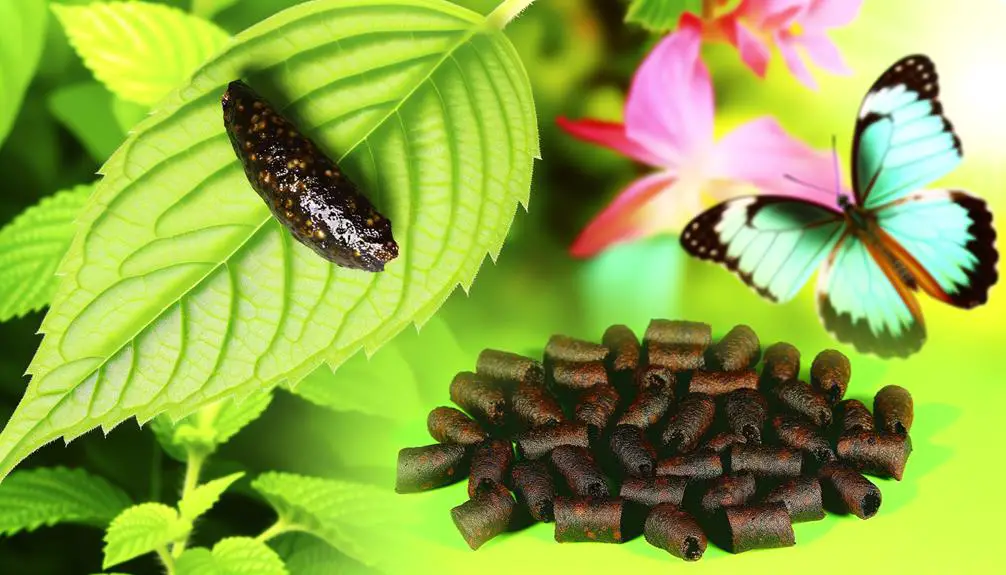
Butterfly droppings, also known as frass, can be identified by their small, pellet-like appearance and color variations depending on the butterfly species and their diet.
Typically, frass measures a few millimeters in diameter, with colors ranging from dark brown to greenish, influenced by the pigments in the butterflies' food sources. The texture can be granular or slightly moist, depending on recent feeding.
Observing frass can provide valuable insights into the health and diet of butterflies in a given habitat.
Additionally, frass can sometimes be mistaken for other insect excrement; however, its unique size and shape, along with the presence of butterflies, aid in accurate identification.
Recognizing frass is essential for entomologists monitoring butterfly populations and their ecological impact.
Scientific Studies
Numerous scientific studies have focused on understanding the complex life cycles, behaviors, and ecological roles of butterflies. Research in this domain has uncovered significant insights into their physiology and environmental interactions. Butterfly feces, often referred to as frass, have been scrutinized to reveal their dietary habits and contributions to nutrient cycling.
Key findings include:
- Nutrient Recycling: Butterfly frass enriches soil with essential nutrients.
- Diet Analysis: Provides clues about the specific plants consumed.
- Health Indicators: Reflects the physiological well-being of butterflies.
- Species Identification: Assists in identifying butterfly species based on frass characteristics.
These studies underscore the intricate link between butterflies and ecosystem health, emphasizing the importance of ongoing research.
Fun Facts
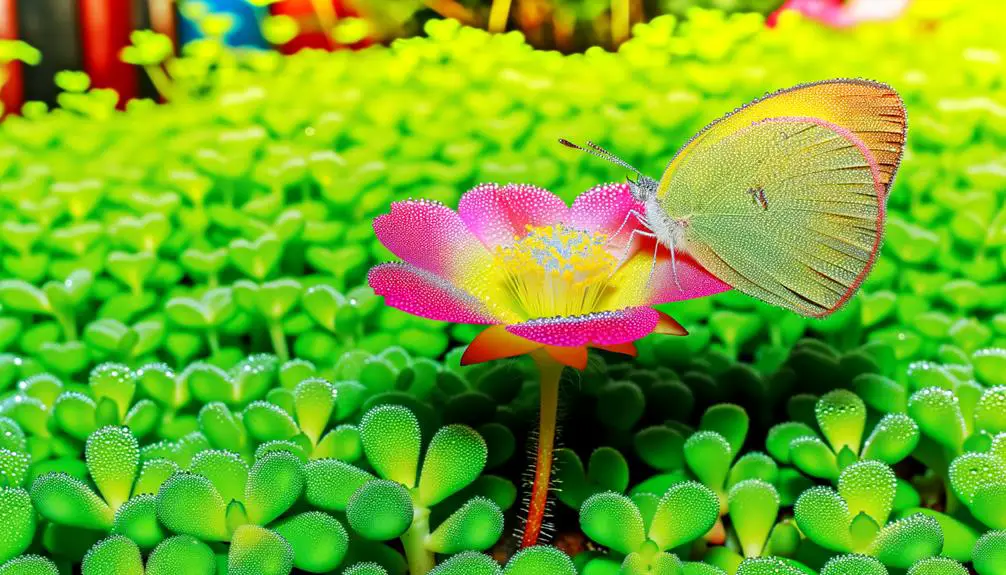
A fascinating aspect of butterflies is their ability to taste with their feet, which enables them to identify suitable host plants for laying eggs. This unique adaptation guarantees that caterpillars have a proper food source upon hatching.
Additionally, butterflies exhibit a behavior called 'puddling,' where they congregate on wet soil or mud to extract essential minerals and nutrients. These minerals play a vital role in their reproductive success.
Curiously, butterflies have a long proboscis, a specialized mouthpart, which they use to sip nectar from flowers, demonstrating their role as important pollinators.
Despite their delicate appearance, butterflies can travel great distances during migration, with the Monarch butterfly famously covering up to 3,000 miles.
Conclusion
In summary, the excrement of butterflies, though often overlooked, plays an essential role in ecosystem dynamics.
Composed largely of liquid waste derived from nectar, these droppings vary in appearance, color, and texture, akin to nature's own brushstrokes on a canvas.
Scientific studies have illuminated the specific characteristics and ecological significance of butterfly waste.
Identification of such droppings can provide valuable insight into the health and behavior of butterfly populations, underscoring their importance in biodiversity.



